Introduction
The Complete Series Planner
PlotRocket's goal is to help you plan and produce a comprehensive series bible and a script-ready outline for every episode of your series, be it a TV show, movie franchise, audio drama, novel sequence, or comic book.
To do this effectively, we offer tools that approximate the structure and process of a story being broken in a writers' room. We also take advantage of the digital format to do things that are hard to pull off on a cork-board, while maintaining the "easily created, easily destroyed" ethos of the venerable index card.
It is possible to construct a perfectly believable space empire with a carefully arranged collection of index cards. The rub? Figuring out what goes on the cards, and how to arrange them so that they stir and engage.
You need structure and process, and a language to talk about them with.
Story Elements
In the domain of screenwriting, there are fuzzy terms like "arc" and "beat" that can mean almost anything, or that are used synonymously like "hook", "teaser", and "cold open" that some will argue are completely different things. Lingo may vary by showrunner, room, class, or book, but the important bits are nearly universal.
PlotRocket defines clear terms for the moving parts of an episodic story and their relationships to each other.
- Series - Basic info about the show.
- Precinct - The hub of your story world.
- Character - A person who will appear in the show.
- Setting - A location where things will take place.
- Lore - History or relationships between characters and/or settings.
- Arc - A story told in beats, spanning seasons, episodes, or acts.
- Season - A group of episodes with an inciting incident and a climax.
- Episode - A published story unit, advances series and/or season arcs.
- Plotline - One of the stories told in an episode. Has an arc.
- Act - A distinct episode section with scenes advancing plotlines.
- Scene - One or more beats taking place in the same setting.
- Beat - A key story moment, can be in a scene, plotline, or arc.
Workflow Components
Creating the story elements and weaving them into a compelling story requires some sort of workflow, composed of a set of components that solve for the different challenges along the way.
After all, dreaming up characters and their relationships is very different process from dialing in the pacing of an episode. You need tools that fit the particular creative context.
- World Building - Conjure your people, places, relationships.
- Arc Plotting - Plot changes in fortune for the story world and those within it.
- Story Breaking - Advance arcs and deepen characters with plotlines.
- Plot Blending - Weave your plotlines into the acts of an episode.
World Building
Describe the precinct of the show, create characters, settings, and lore that will inform all the stories to come. The more detailed and coherent your world, the more authentic the stories you tell about it will be. Do as much or as little as you want to start, add more depth when you need new story ideas.
Arc Plotting
With at least some part of your world built, you can begin to think about how characters and narrative will change over the course of the series.
Using arcs, you can plot the ups and downs of a character, relationship, theme, narrative, or the world itself over the course of some number of seasons or episodes. Beats of an arc are moments you plan to include in the show well before you get around to breaking the season or episode they appear in.
Story Breaking
Seasons have an inciting incident and a climax. You should have solid ideas for those before venturing far into breaking episodes beyond the pilot. These events bookend all the season's arcs.
At the episode level, you break a story by coming up with plotlines (often referred to as A, B, and C stories). A plotline has an arc, spanning the acts of an episode. Its beats tell the story of that plotline.
Plot Blending
When you have the plotlines for an episode, you need to blend their beats across the acts of your show, turning them into scenes or moments within scenes. Drag and drop beats from your plotlines into acts or scenes and see visually which scenes contribute to the selected plotline.
Fastest Path To Joy
Figuring out how to take an idea and turn it into a series is a big task. You want maximum return on every good notion, whenever it comes. Structure and process are what turn all those thoughts into a story and not just a pile of notes.
For every story element you create, PlotRocket intentionally seeks to provide the fastest path to joy.
A Common Example
The character bio is an information-dense element. For some, sitting down to fill in the bios of an ensemble of characters they don't have a feel for yet can seem like an unsurmountable and joyless chore.
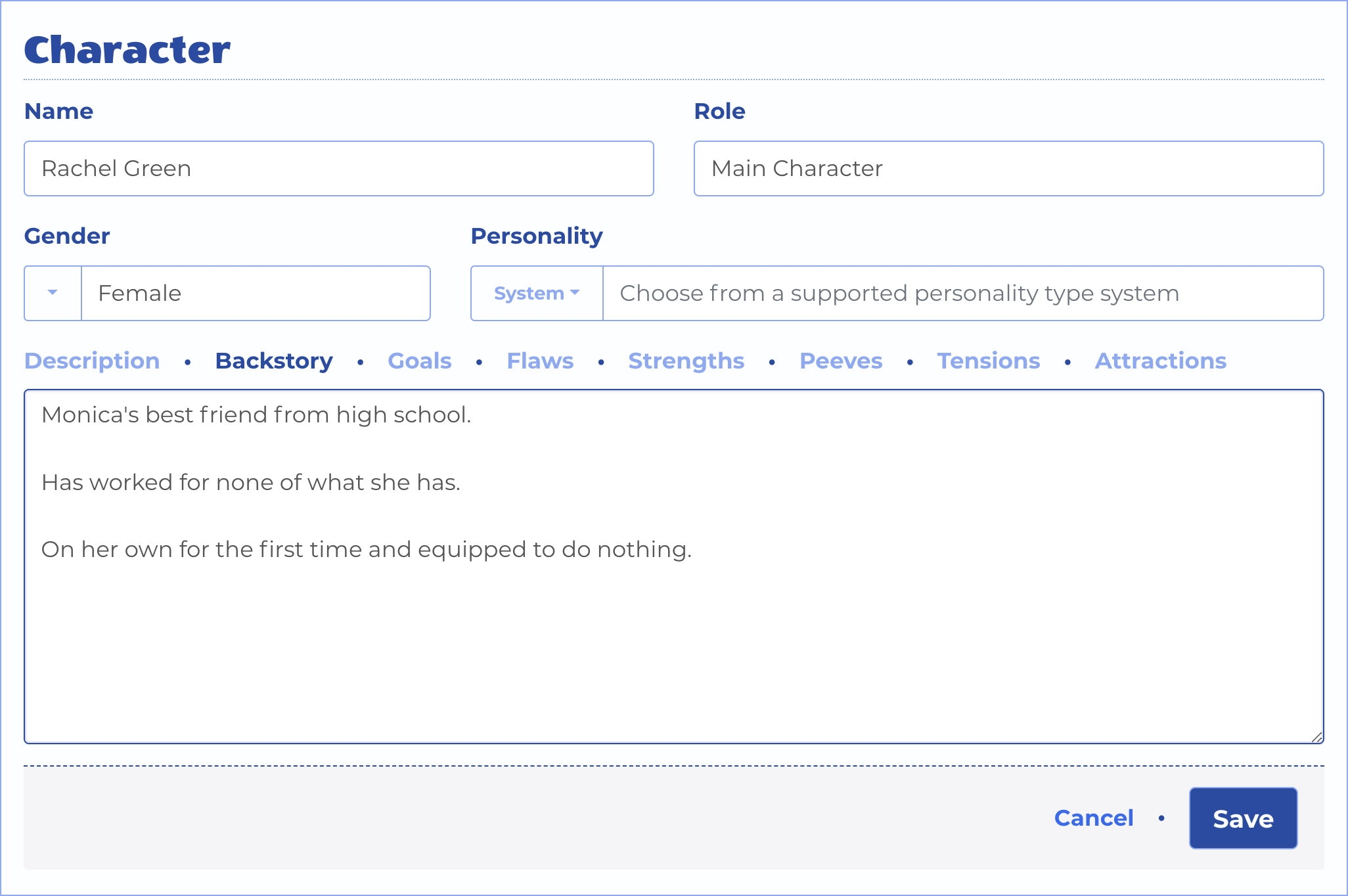
The Character Form
If you're just trying to get a sense of what characters might be in your show and their relationship dynamics, you don't need to feel guilty about all those empty fields you'll be skipping for now. No need to even open the Character form.
Character Chips
Just hop into the Tile View where you can quickly create characters with just a name.
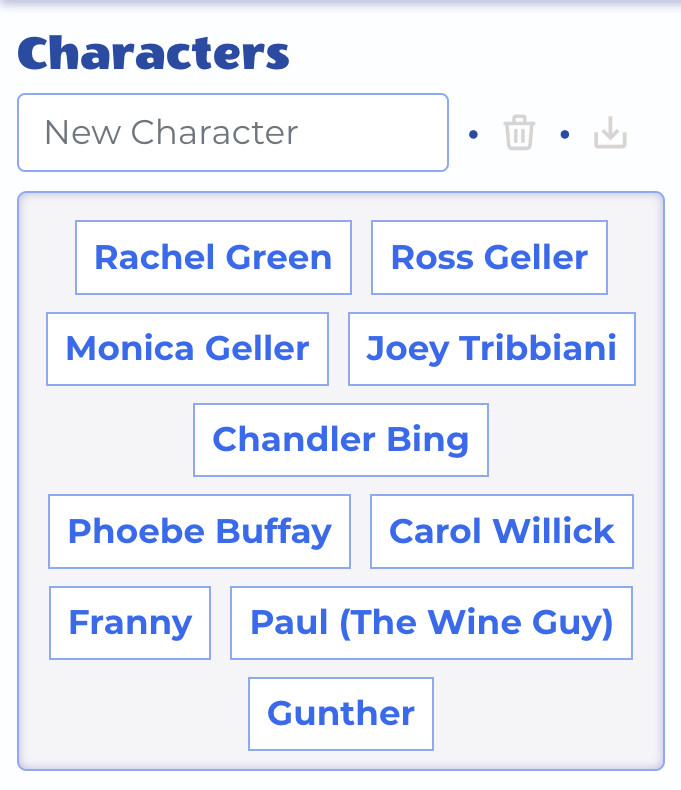
Character Chips in the Tile View
Lore Tiles
Drag and drop character chips to rearrange them or create Lore entries where you can build the relationships, rivalries, and obsessions that will drive the story.
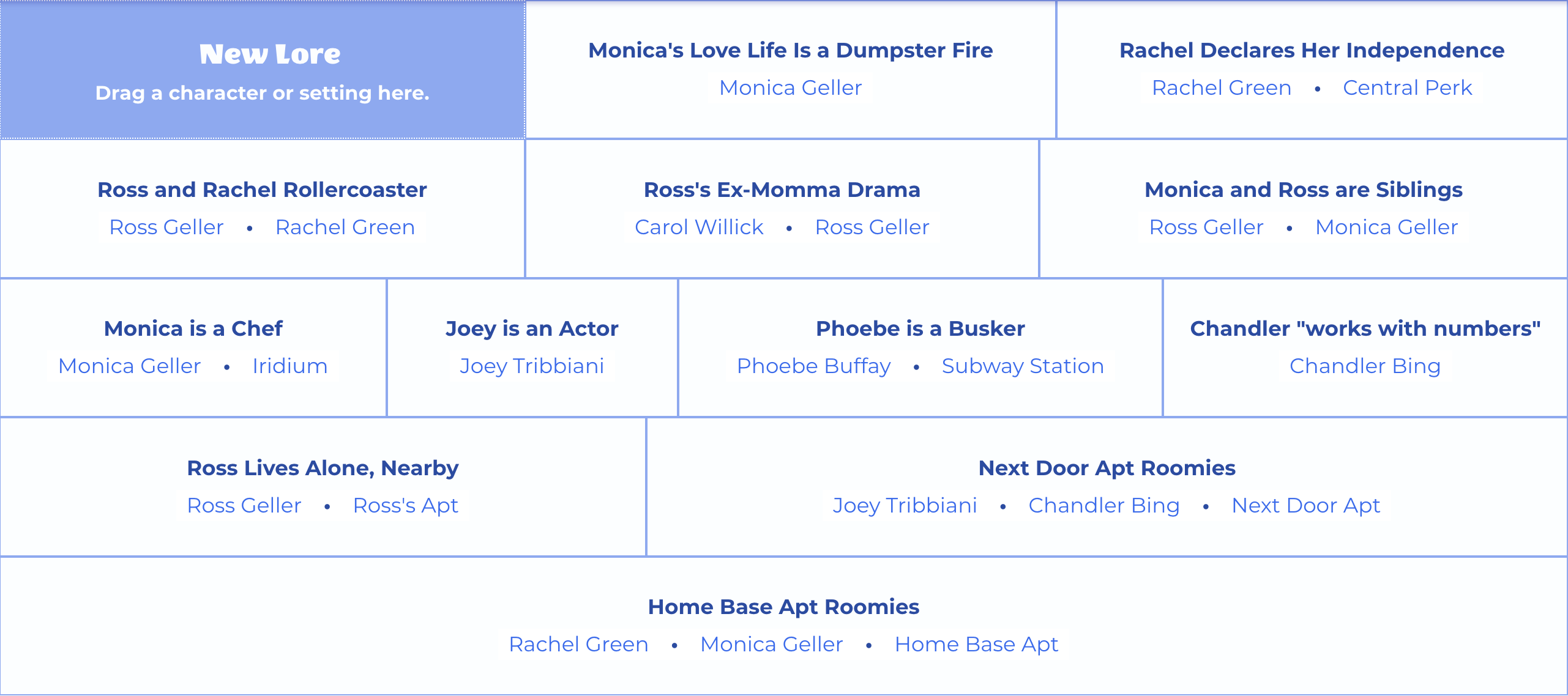
Lore Tiles in the Tile View
Lore is added to the top of the Tile View. Drag the bedrock lore that drives the entire show to the bottom. As new lore comes in to drive seasons and episodes, it goes on the top, easiest to reach and edit.
To build the show's world, you'll create the characters, settings, and lore that will form its foundation. This is an ongoing process, and they don't all have to be there before plotting or breaking your story.
If you create a piece of lore about a relationship between two characters and later decide you don't need any of it, then very little was ventured so you don't have to feel bad about tossing it out.
Conclusion
Since the most engaging stories are about people and relationships, it's important to be able to generate and evaluate those quickly. Constructing the social graph before you know much about the characters lets you identify traits needed to make their relationships work. To learn who your characters are from the places they hang out and who they associate with.
That's why it wasn't enough to offer cards and forms to manage all of the story world's elements. The addition of Tile View was explicitly about finding the fastest path to joy.
Screen Size Support
Recommended Use
PlotRocket is designed for use on a desktop or laptop computer. It will work on an iPad Pro in landscape mode, but that's about as small as you want to go.
This design is owing to the nature of the workflow tools, which need turf to be useful, and because it's where most writers do their work anyway.
Below are a few examples why this is so.
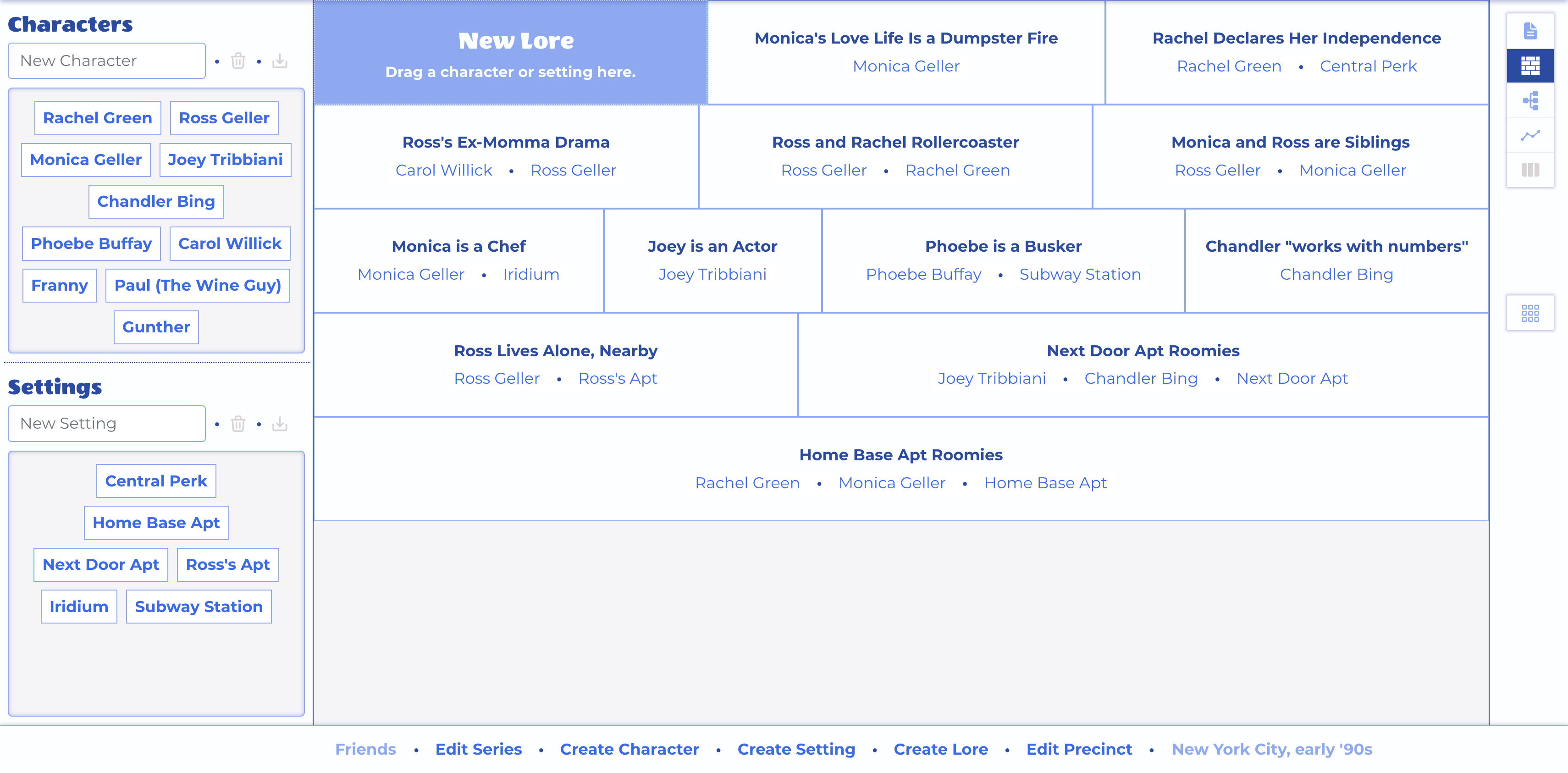
Create characters, settings, and lore about them in a drag and drop environment.
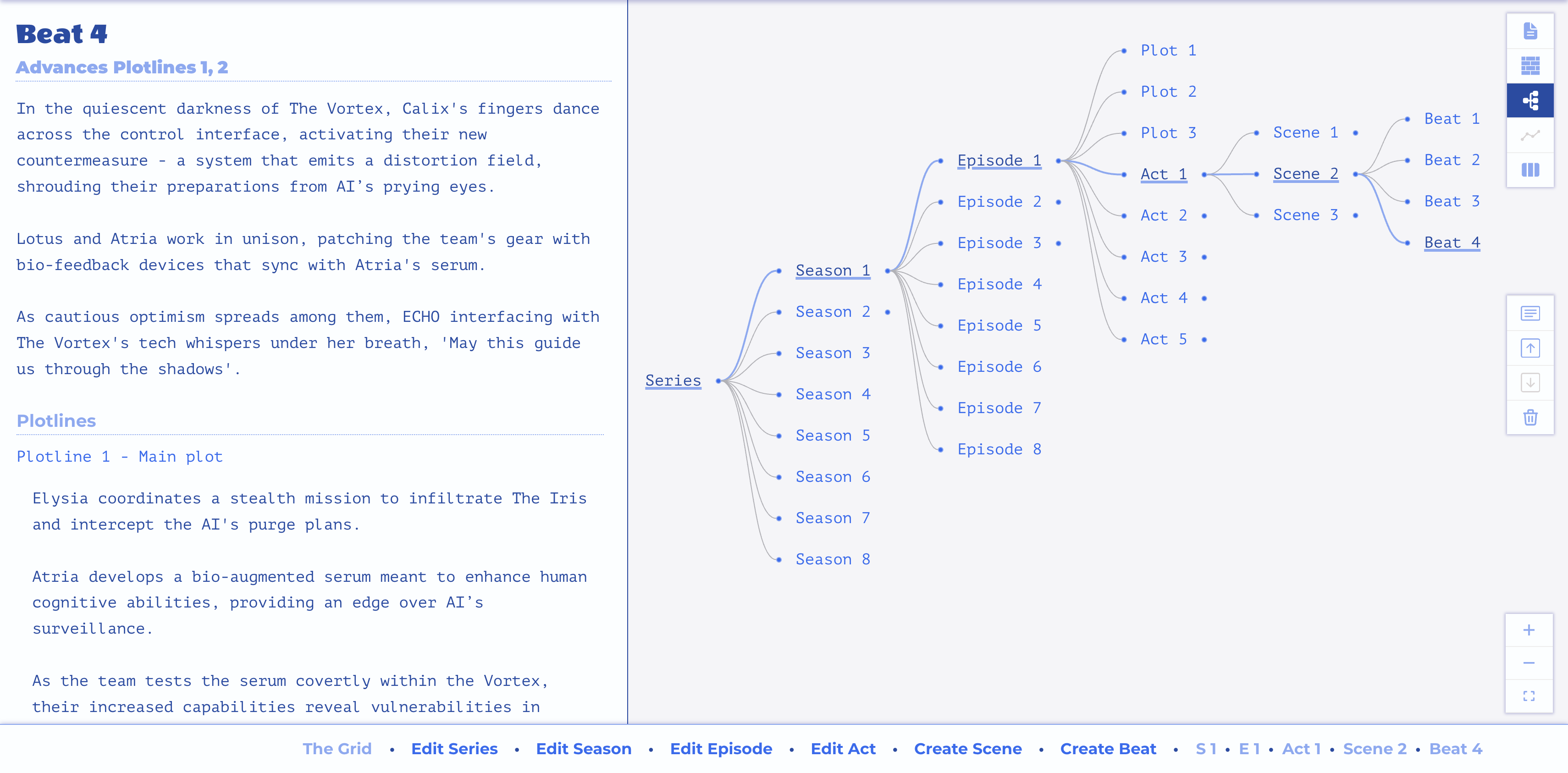
Visualize, navigate, and manipulate the structural hierarchy of your series.
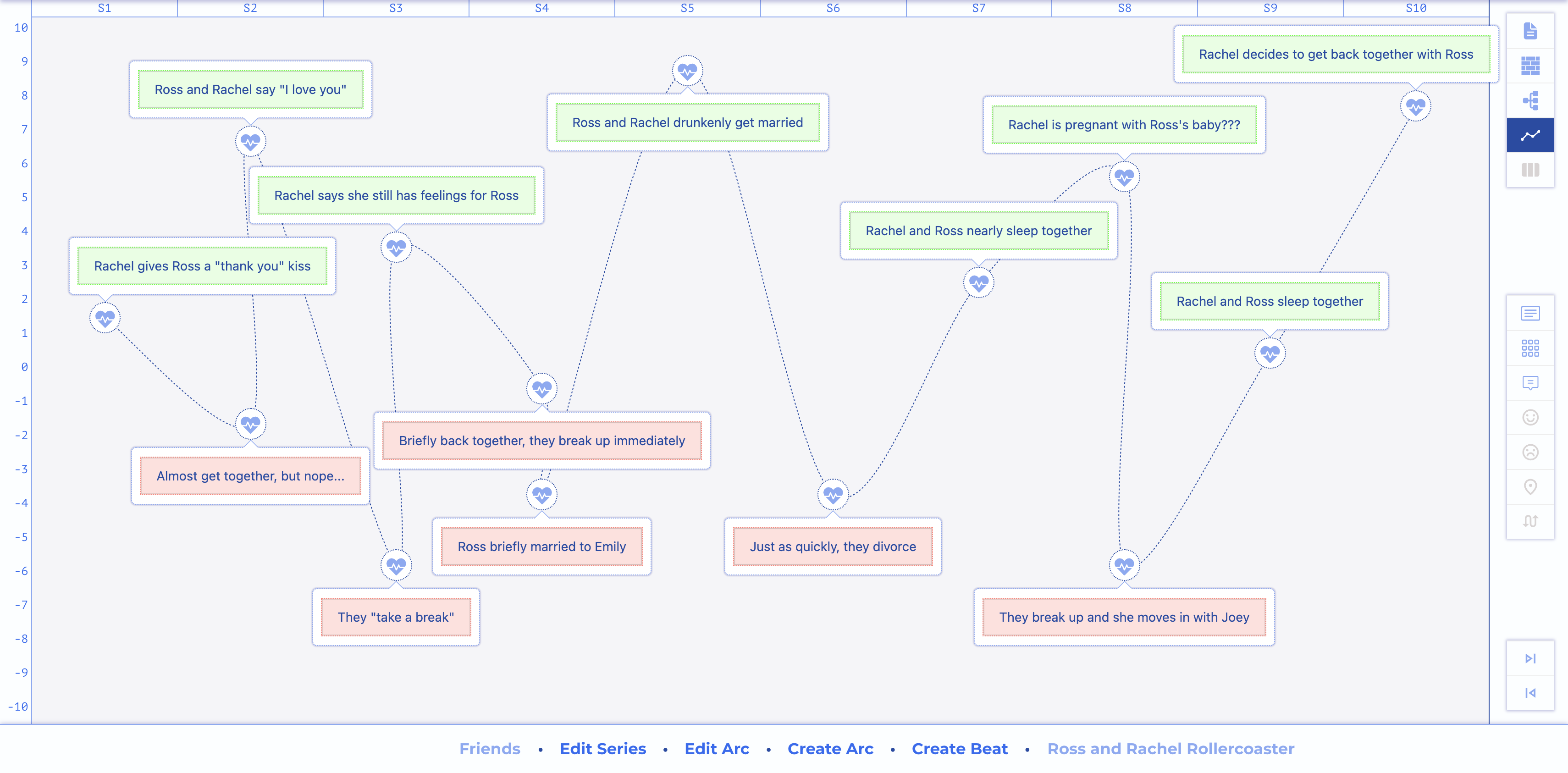
Plot arcs with beats that describe changes to your characters, narrative, and more over time.

Blend the beats of an episode's plotlines into the acts and scenes of the final outline.
Behavior On Smaller Screens
When the app is displayed on a device or window below a certain size or outside the usable aspect ratio, it switches over to display the manual.
Minimum Width
1180px
Minimum Height
820px
Minimum Aspect Ratio
1.2
Maximum Aspect Ratio
2
